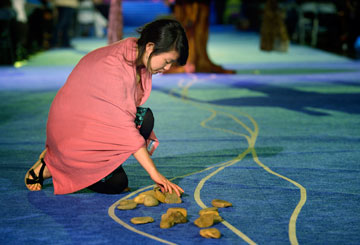"Repentance by itself makes the repentant feel good. We cannot just apologize. We need to focus on healing relationships. And then we need to realize that the learning is just beginning."
Blenda Smith speaks from experience. The white laywoman from the Upper New York Annual (regional) Conference has served as a director of the United Methodist Commission on Christian Unity and Interreligious Concerns since 2004. Smith said she has moved from "cluelessness" to awareness, especially about the concerns of Native Americans and other indigenous people.
Eight years ago, Smith began working with another director - the Rev. Carol Lakota Eastin, whose heritage is Lakota, Yakima and Shawnee. Smith and Eastin, pastor of First United Methodist Church in Rantoul, Ill., were part of the team that planned the "Act of Repentance toward Healing Relationships with Indigenous Peoples" at the 2012 General Conference in Tampa, Fla.
At the close of that service, delegates picked up symbolic stones from the "river of life" scattered in the worship area. They were encouraged to take the stones back to their communities "as a covenant to continue to listen and to walk the journey of healing with one another."
That service was meant to be a beginning, Eastin said.
"During the next four years," she explained, "we're calling the people of The United Methodist Church to enter into a longer journey of conversations with indigenous people."

Skylar Corbett-Hecocta, a member of the Klamath tribe from Oregon, blesses The United Methodist Church by holding his stone toward the north, south, east and west and the sky. A UMNS photo by Kathleen Barry.
For some conferences, the process started years ago. For others, it is a new adventure. However, Eastin believes all can find something helpful in a new guide prepared especially for annual conferences and local churches. Produced by United Methodist Communications and sent to annual conferences in June, the guide is on a two-disc DVD resource.
Each week of the 11-week curriculum features a video, along with Scripture and discussion questions. It features interviews conducted during the 2012 General Conference with Otto Braided Hair, the Rev. Thom White Wolf Fassett, Bishop Robert Hayes, the Rev. Chebon Kernell, the Rev. Beauty Maenzanise, Gladys Mangiduyos, the Rev. Anita Phillips, the Rev. Yngvar Ruud and retired Bishop Melvin G. Talbert. The guide also includes a reproducible leaflet, "Giving Substance to Words."
Long journey
The journey to the 2012 Act of Repentance began at the 2000 General Conference. The first service of repentance stated the sins of racism for which the church was responsible and asked the African Methodist denominations for forgiveness. In 2004, A Service of Appreciation for Those Who Stayed was dedicated to the African-Americans who kept their membership within The United Methodist Church. Four years later, Truth and Wholeness: Understanding White Privilege called white United Methodists to acknowledge their unearned privilege and seek to move beyond it.
Eastin and Smith wrote the study guide.
"The service of repentance and healing helped us begin to see a small part of our history and the beginning of repentance," Smith said.
She credited Stephen J. Sidorak Jr., who heads the commission, with creating an advisory council, chaired by Fassett.
"Over our years together," Smith recalled, "we pulled together some incredible minds that told us, 'We can't just repent.'"
She said the experience helped her to recognize white privilege and "the present-day trauma" with which indigenous people live. "It's part of who they are. They are never given the acknowledgment and honor they need."
First steps

A delegate picks up a stone in the aisle during the Act of Repentance at the 2012 General Conference in Tampa, Fla. A UMNS photo by Paul Jeffrey.
Eastin offered some first steps:
- • Work with your annual conference committee on Native American ministries and your bishop. Recalling the Acts of Repentance service at General Conference, she said, "The bishops are the ones we called to action. We asked them, physically, to take a step forward. It was a powerful moment."
- • If your congregation or charge does not have a designated person to represent Native American concerns in the local church, assign one. (See the Book of Discipline, Par. 654.) Work with your annual conference cabinet secretary to get the designated person's name added to the charge conference form.
- • Notice who your neighbors are. If you don't think you have Native American neighbors, look again. Once you discover the Native Americans in your area, learn their stories.
- • Foster relationships with Native Americans in your community. "An ideal model is First United Methodist Church in Sheridan, Wyo., that started a relationship with the Native Americans down the road," Eastin said.
- • Recognize that indigenous people worldwide share similar struggles. She cited the Maasai (cattle people) of Kenya as an example. "It's another world," Eastin said. "Then again, it's the same." The Maasai today are striving to protect their remaining lands and to gain legal control of their sacred sites to protect them from commercial exploitation.
Smith's local church will use the study guide this autumn. "It's a very easy program to lead," she said, "and I'm looking forward to it." She said there are six Native American tribes within her conference, and the committee on Native American ministries will help them use the resource "with integrity."
The time has come, Eastin added, for "indigenous people to take their full and rightful place in the church and the community."
*Dunlap-Berg is internal content editor for United Methodist Communications, Nashville, Tenn.
News media contact: Barbara Dunlap-Berg, Nashville, Tenn., (615) 742-5470 or [email protected].
Like what you're reading? Support the ministry of UM News! Your support ensures the latest denominational news, dynamic stories and informative articles will continue to connect our global community. Make a tax-deductible donation at ResourceUMC.org/GiveUMCom.




